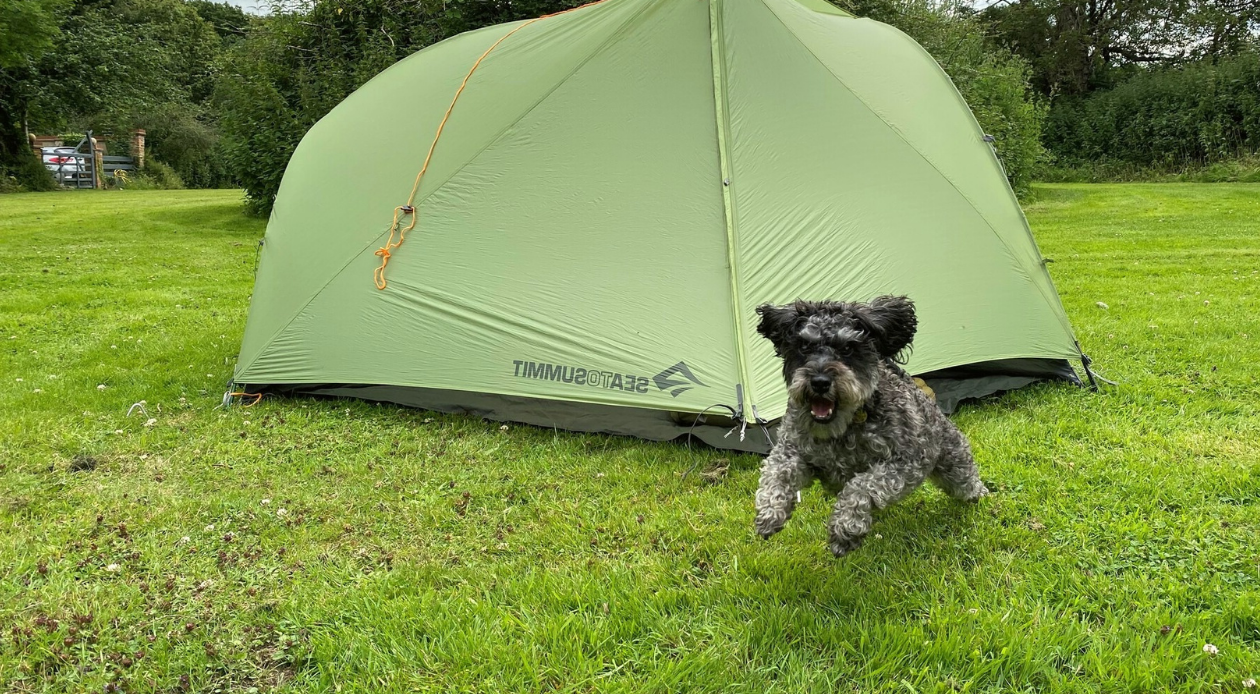
Camping with dogs
A camping trip is one of the best ways to enjoy a holiday with your dog.
Camping is a brilliant way to explore the great outdoors with your dog. It can be an exciting sensory experience for your furry friend, but it can also feel a little overwhelming. Here are key things to know before you bring your dog camping.
Important
Research your chosen campsite thoroughly ahead of time. Even some dog-friendly campsites have access restrictions for dogs, or do not provide facilities such as poo bins.
Getting your dog used to the tent
If your dog has never been camping before, it’s best to try to get them used to it before you go. Pop the tent up in your garden while your dog watches you. You can reward them with praise and treats for calm behaviour around the tent.
As your dog will be sleeping in the tent with you, you’ll also need to get them used to being inside it. Dogs are often not used to such a confined space and the lack of windows may make them worry. Bring their favourite bed and blankets for comfort and familiarity.
Try to encourage your dog inside the tent with lots of praise and treats and calmly sit next to them inside. Leaving the tent up all day and going in and out with them in short bursts will be the best way to encourage them inside with you.
First aid preparation
While you’re camping with your dog it’s important to be prepared for medical situations. Ensure your dog is fully vaccinated before you leave for your trip. Prepare a dog first aid kit in case of any emergencies, along with any medication they may need. Research vets in the local area and keep a note of their contact information.
You should also:
- stay alert around your dog and bonfires – the ground can stay hot for hours after a fire has been put out. Be sure to keep your dog on a lead around the fire pit.
- check your dog daily for ticks, especially after walks, and bring a tick removing tool
- avoid sharing human food ‒ such as meat from the barbecue ‒ with your dog. Too many treats can upset their stomach. Take extra care to prevent your dog from eating leftover bones.
- ensure your dog's ID tags and microchip information are up to date with your mobile number so you can be contacted if they go missing
Camping with dogs in the heat
Camping is far more tempting when it’s hot. While we may relish the heat, our dogs often really struggle. Try to find a camping spot in a shaded area and never leave your dog in a hot tent on their own. A tent can act like a greenhouse and heat up really quickly.
Know the signs of heatstroke in dogs and keep them in the shade during the hottest parts of the day. Think about ways you can keep them cool and always provide an accessible source of fresh water.
Camping around livestock
Many UK campsites are based on or near farmland. Be extra careful around livestock with your dog – they need to be placed on lead. You should also ensure your dog doesn't disturb other campers. Whether you’re at the campsite or out and about, ensure your dog knows their recall cue in case they encounter any distractions off lead.
Important
It’s a criminal offence to allow your dog to chase or attack livestock, and farmers can shoot dogs they believe are worrying livestock on their land.
Dog camping essentials
Use this handy packing list to prepare for camping with your dog.
- Bed and blankets ‒ A familiar place to sleep will help your dog to settle at night, and provide a place of respite during a busy day
- Dog crate ‒ If your dog is used to them, a dog crate can provide a quiet, secure space for them to settle down in private.
- Treats and chews ‒ Giving your dog a nice chew or treat ball can keep them entertained while you’re focused on a barbecue
- Food ‒ A resealable container will keep food fresh and prevent unwanted visitors such as ants
- Bowls for food and water ‒ An increase in exercise or warmer weather can mean less hydration. Collapsible bowls are also useful for hiking and activities.
- A long line ‒ Having your dog on a long line on walks will give you reassurance that they can run around if they want to, but won’t be able to chase after any nearby wildlife
- Harness ‒ If your dog is not used to the countryside, they can sometimes pull a little more on the lead as they try to sniff out new things. Having a harness will make sure that any pressure from pulling isn’t placed on their neck and will also help if you want to have them permanently on lead.
- Tie-out stake ‒ This allows you to place your dog’s lead onto a pole that is twisted into the ground, meaning you can get on with camping activities while your dog is safely tethered.
- Wind break ‒ Providing a wind break or some form of screen gives your dog some privacy, especially if they’re on a tether. If your dog is worried or frustrated by other dogs passing, a wind break can help settle them and stop the barking.
- Towel ‒ keep a towel handy for wiping your dog down after a muddy walk
Page details
Reviewed
• 24 May 2023
Next review
• 25 May 2026





